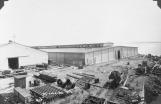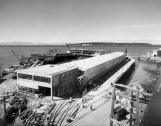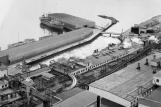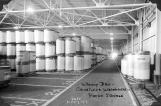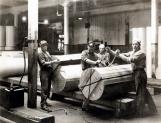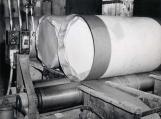27
Ships in the harbour awaited the loading of finished product. The method of moving the reels of paper from the Finishing Room to the Warehouse saw many changes over the years. As production increased so did the need for warehouse space. Towards the end of 1926, the mill was producing and warehousing some 137,000 tons of newsprint per year. At the beginning of 1930, the warehousing needs had increased to 182 thousand tons and by 1960, that figure had increased to over 500 thousand tons.29
April 6, 1952. Construction of a wharf warehouse at the Powell River mill.31
August 25, 1955. A view of Powell River mill waterfront and "D" Dock taken from the smokestack. There is a ship loading paper at the dock.33
Two features of the new warehouse are of special interest.1) Mobility has been greatly increased by the complete absence of pillars inside the warehouse. The entire floor area is unobstructed and storing and loading operations can be speeded up. From the consumer angle, this absence of pillars will indirectly cut down the possibility of damage at the storing and shipping points.
2) Along the seawall side, the warehouse wall represents a continuous series of sliding doors, which allow expanded accessibility and permit loading of ships without interference. Rolls can be placed on the dock at any point desired and hauling distance reduced to a minimum.
In planning the layout of the new sheds, the following factors represented the basic foundation which guided construction.
1) Pulp and paper should be moved the shortest possible distance from the finishing room to the ultimate point in the shortest possible time. This involves the complete elimination of temporary storage and railroad switching.
2) Paper should be handled only once in movement from finishing room to the pick-up point on the storage floor.
3) Rail movement is cheaper than jeep movement.
4) Paper packets (rolls of uniform customer size) should be grouped separately.
5) Rolls and packets should be located in storage as close as possible to the ultimate dispatch point.
6) Accessibility is important to low-cost maintenance and shipping.
7) Reduction of "dead" space in warehouse by elimination of runways, passageways, etc., with highest possible ratio of live space to dead space.
8) A layout based on 50 years' life, capable of adjusting itself to the wide assortment of operating conditions that would prevail in this period. Maximum flexibility is to be aimed at.
These were some of the principles on which the original plans were drawn up, and which had been refined through long discussions between practical operating staffs. The new warehousing building will have a capacity of about 10,000 tons. Deep-sea and coastwise storage facilities have been separated, and the outer wharf, which will provide berthing facilities for ships of 410 feet and 480 feet, will have a 6,000-ton capacity warehouse, to allow 3,000 tons for each vessel loading. The basin will be dredged to a minimum depth of 30 feet. This building will be 120 feet wide, 420 feet long and 27 feet in height. Along the wharf side a 30-foot wide working apron will extend along the entire length.
At the landward end, a 4,000-ton warehouse will be constructed with a width of 50 feet, 480 feet long, 24 feet high. Depth of water will be 25 feet, and berthing facilities for simultaneous docking of two 150-foot scows and one small motor ship will be provided.
Administration offices, freight shed and employee facilities are located at the eastern end of the shore quay, and are sited for maximum accessibility.
Powell River Digester
Vol. 28 No. 1
January-February, 1952
35
One of the most important concerns of our shipping department lies in adequately protecting, from the hazards of numerous handlings, transference, etc., every shipment of newsprint leaving the mills of Powell River. This calls for careful consideration, selective judgement, and a thorough knowledge of every possible eventuality that may arise between the point of loading and the place of final disembarkation. The illustrations accompanying this issue show a case in point.This shipment, as mentioned elsewhere, is destined for the big presses of La Nacion, in Santiago, Chile. Each roll is defended with the strong, sturdy, barrel packing to resist the heavy transportation demands of the voyage from Powell River to the Chilean capital. This special type of packing is used when conditions necessitate extensive transference and shifting, and unavoidable rough usage. In this particular instance the paper traveled six thousand miles by water to the Port of Valparaiso. Here it must be transferred in mid stream to lighters, ferried ashore, slung on the wharf, again loaded on waiting trains, to proceed overland for a distance of more than a hundred miles to Santiago. Transferring the paper from the hold of the ship to the comparatively frail lighters augments the possibility of damage; and the hazard is increased by the frequent handlings from lighter to wharf, from the wharf to the train, with additional transference to trucks at destination. For this reason the staunchest protection is essential to assure its safe and undamaged arrival at the door of La Nacion, In Santiago. And such protection is afforded by the barreled rolls.
Powell River Digester
Vol. 7, No. 12
December, 1928
37
An interview from the Finishing RoomYou started as a capper-that was crimping by hand and doing the wrapper. Then you were jeep driving. No, there was a skip man before that. There was an up ender - when the rolls were down the lowerator, they were set up by machine, and they put a wooden skid on there, where the rolls fell on, and the jeep came and picked the skip up and took two rolls away. So every time there had to be a guy who put the skips on, so you went from capper to skip man to jeep driver, and then you went to scaler - that was the guy who would scale the rolls and put the weight stamps on each and recorded them, and that was the top job at the time in the old finishing room. [The capper wrapped the whole roll - there were two people at that job]. And then the scaler, he put the labels on with the weight, and the labels for where it's supposed to go - to Seattle or to Vancouver, that label was put on there, and he stamped the weight on it, and he has to record it on his sheet to keep the record straight.
Transcript of interview tape
People of the White City
39
Coincident with the big speedup and conversion operation on Number 7 paper machine, and with the installation of a third winder to permit greater efficiency on Number 7 and 8 machines, a further significant advance in plant modernization has been completed at Powell River.This is the new automatic roll handling system, one of the most modern in the pulp and paper industry.
Embodying the main features of similar installations recently introduced in Alaska and United States, Powell River has carried the automation process considerably beyond any presently known equipment. Two principal new features are:
1) Automatic shaft handling.
2) Almost automatic core feeding.
It is not the intention here to go into technical details of the new equipment. But a brief description of the old methods of roll handling coupled with the accompanying pictures of the modern installation may help the reader to understand something of the changes that have been made-made without interrupting newsprint production.
In the old method the paper machine crews had to handle a set of rolls every 20 minutes by air hoist, from winder to wrapping drums, manually extracting a 400-pound shaft 22 feet long, juggle the shaft back to the winder on a small dolly and manually reload it with cores before putting it back on the machine. After wrapping, the rolls were again manhandled on dollies, whirled across the floor and pushed off the dollies onto the lowerator to the finishing room.
This entire operation, as the photographs show, is now almost entirely automatic. In the finishing room where the rolls are wrapped for final shipment, the same conversion has taken place. Rolls are moved, turned or tipped by pressing buttons. A press of the foot starts the wrapping process, and a "flying wire" cuts the wrapper.
Weighing, upending and transportation to trucks are all in the same airy atmosphere-and the whole process is an imaginative and fascinating one for which local engineers and technical men have been highly praised by visiting experts.
Powell River Digester,
Vol. 32, No. 3
May-June, 1956.
